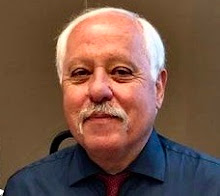 Had a reasonably decent night's sleep in my room at the Hotel Cristoforo Colombo the first couple of days, probably due to total exhaustion from the full day of travel on September 7.
Had a reasonably decent night's sleep in my room at the Hotel Cristoforo Colombo the first couple of days, probably due to total exhaustion from the full day of travel on September 7.
My hotel room turned out as advertised in Lonely Planet: Italy. It was very nice but moderately priced (three-star), lacking in some of the amenities available at more expensive hotels (like wi-fi in the rooms, although they did have Internet access in the lobby) but providing many of the basics needed by most people. For me, it was perfect.
 The best feature of the hotel -- in addition to my hosts, Libero and Patrizia Sterlocchi (above) -- was the rooftop terrace where the sunsets were stunning over medieval Genoa.
The best feature of the hotel -- in addition to my hosts, Libero and Patrizia Sterlocchi (above) -- was the rooftop terrace where the sunsets were stunning over medieval Genoa.
Breakfast was served every morning on the terrace (left, behind the yellow building), which saved me many euros, and the fare included eggs, ham and salami, pastries and bread, fruit cocktail and, as you might expect, my choice of coffee.
 The hotel received its name from the birthplace of the legendary explorer (right), which was but a mere frisbee toss from the front door. Some question whether Columbus was born in Genoa or the nearby island of Corsica, but most believe he was a native Genovese.
The hotel received its name from the birthplace of the legendary explorer (right), which was but a mere frisbee toss from the front door. Some question whether Columbus was born in Genoa or the nearby island of Corsica, but most believe he was a native Genovese.
"In 1492, Columbus sailed the ocean blue," or so the expression goes. The conventional wisdom is that Genoa's native son "discovered" America.
Of course, the "native Americans" were mistakenly identified by Columbus as "Indians" (India is where he thought he had landed; instead he landed on San Salvador in the Carribean). These indigenous peoples had supposedly migrated over a land bridge from Asia to Alaska and down the coastline to the Americas.
Then, there's Eric the Red and his boy Leif Ericsson, the Vikings who discovered Iceland and Greenland, respectively, prior to the initial voyage of Columbus to the "New World."
 As an aside, I flew over Greenland on my way to Frankfurt; I can tell you first hand that there is nothing "green" about Greenland, even during summer in the Northern Hemisphere.
As an aside, I flew over Greenland on my way to Frankfurt; I can tell you first hand that there is nothing "green" about Greenland, even during summer in the Northern Hemisphere.
Regardless, the birthplace of Columbus, as witnessed by the steady flow of tour buses (above) rolling by my hotel on Via Porta Soprana, is a popular tourist attraction. The columnar structure (below) was originally the cloistered garden of a nearby monastery where monks and nuns would pray and tend their crops. In the 1930s, Mussolini initiated a restoration of Genoa and had the garden converted to a stock yard for horses and mules.
Just one of a multitude of reasons the Genovese loathed "Il Duce."


No comments:
Post a Comment